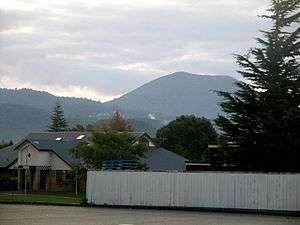Taupo District
The Taupo District is a district in New Zealand. It covers 6,350 km² of land, as well as a further 610 km² of lake area, both in Lake Taupo, New Zealand's largest lake, and also in the smaller Lake Rotoaira. The district stretches from the small town of Mangakino in the northwest to the Tongariro National Park in the south, and east into the Kaingaroa Forest. The district's population is largely located in the two main centres, Taupō and Turangi.
Taupo District | |
|---|---|
 Eastern Lake Taupo, Turangi to Taupo | |
 Logo | |
Location of Taupo Territorial Authority within New Zealand | |
| Country | New Zealand |
| Regions |
|
| Main towns and settlements | Taupo, Kinloch, Turangi, Mangakino |
| Government | |
| • Mayor | David Trewavas |
| • Parliamentary electorate | Taupō |
| • Territorial authority | Taupo District Council |
| Area | |
| • Total | 6,970 km2 (2,690 sq mi) |
| Population (June 2019)[1] | |
| • Total | 39,300 |
| • Density | 5.6/km2 (15/sq mi) |
| Time zone | UTC+12 (NZST) |
| • Summer (DST) | UTC+13 (NZDT) |
| Postcode(s) | |
| Area code(s) | 07 |
| Website | taupodc.govt.nz |
Local government
The district is governed by the Taupo District Council, with the vast majority of the district falling within the jurisdiction of Waikato Regional Council.
History
Little is known about early Māori settlement near Taupō, although Ngāti Tūwharetoa have been the main iwi of the area for several hundred years. Major pa were situated at the southern end of the lake to the west of the modern town of Turangi.
Taupo town was founded in 1869 as a garrison town during the New Zealand Wars, but remained small due to the poor volcanic soils of the region. It was not until the 1950s that the region started to develop, with forestry and the construction of the Wairakei geothermal power station.
Population
The town of Taupō is situated on the north-eastern shore of the lake, and Tūrangi is at the lake's southern extremity.
State Highway 1 winds along the eastern shore of Lake Taupo, and several small townships are located along it. Fewer people live on the northern or western shores, although there are several small settlements close to Taupo, and to the west of Tūrangi (notably at Tokaanu).
| Historical population | ||
|---|---|---|
| Year | Pop. | ±% p.a. |
| 2006 | 32,418 | — |
| 2013 | 32,907 | +0.21% |
| 2018 | 37,203 | +2.48% |
| Source: [2] | ||
Taupo District had a population of 37,203 at the 2018 New Zealand census, an increase of 4,296 people (13.1%) since the 2013 census, and an increase of 4,785 people (14.8%) since the 2006 census. There were 13,830 households. There were 18,522 males and 18,681 females, giving a sex ratio of 0.99 males per female. Of the total population, 7,653 people (20.6%) were aged up to 15 years, 6,072 (16.3%) were 15 to 29, 16,404 (44.1%) were 30 to 64, and 7,077 (19.0%) were 65 or older. Figures may not add up to the total due to rounding.
Ethnicities were 76.4% European/Pākehā, 29.9% Māori, 3.2% Pacific peoples, 4.9% Asian, and 1.8% other ethnicities. People may identify with more than one ethnicity.
The percentage of people born overseas was 16.6, compared with 27.1% nationally.
Although some people objected to giving their religion, 51.9% had no religion, 32.9% were Christian, and 8.3% had other religions.
Of those at least 15 years old, 4,359 (14.8%) people had a bachelor or higher degree, and 5,760 (19.5%) people had no formal qualifications. The median income was $30,300. The employment status of those at least 15 was that 14,385 (48.7%) people were employed full-time, 4,854 (16.4%) were part-time, and 978 (3.3%) were unemployed.[2]
The population in June 2019 was 39,300, with 23,900 people in Taupō and 3,320 in Tūrangi.[1]



References
- "Subnational Population Estimates: At 30 June 2019". Statistics New Zealand. 22 October 2019. Retrieved 11 January 2020.
- "Statistical area 1 dataset for 2018 Census". Statistics New Zealand. March 2020. Taupo District (021). 2018 Census place summary: Taupo District